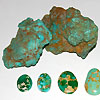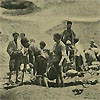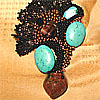- sale
- new items
- lovely beads
- wedding beads
- beads for teens
- for custom order
- newsletter
- recognition
- testimonials
- birthstones
- zodiac signs
- jewelry guide
SHOP BAG
![]() in your bag 0 items
in your bag 0 items
December gem is turquoise. This gemstone played an important role in the development of the cultures in which it was utilized. The history of turquoise use in the Middle East and Egypt coincides with the beginning of civilization itself. Turquoise mining began in the Sinai Peninsula around 5500 BC. The stones taken from these mines served jewelry, amulet and cosmetic purposes for millennia. In 1900, archaeologists who excavated the tomb of the Egyptian Queen Zer (5500 BC) found a turquoise and gold bracelet on her wrist. That's the world oldest known example of surviving jewelry.
In Persia archaeologists have found beads of turquoise that date around 5000 BC. Amulets from 600 AD contained carvings of Islamic and Persian Proverbs. The fine stones from this area were important sources of trade and were found in graves as far away as Turkestan and the Caucasus. These revered stones, so important to the Persian culture, were called Ferozah, which meant victorious. In modern times, Iran honors turquoise as its national gemstone.
The earliest Anasazi peoples in Pre-Columbian America had opened their turquoise mines by 1000 AD and had established extensive trading practices with the peoples of what is now Mexico. The mining locations included locations in Arizona, New Mexico and Colorado. In cities such as Chaco Canyon, the Anasazi traded their turquoise for the feathers of tropical birds. As demand for the Anasazi turquoise grew in the south, the society at Chaco Canyon grew wealthy.
The ancient Turquoise jewelry of the Zuni tribes was characterized by prominent inserts of the stone. Navajo Turquoise jewelry features die-stamped designs. In the 16th century, the cultures of the American Southwest used turquoise as currency. It was also often found on the facades of Indian homes. Aztec turquoise mines began operating between 900-1000 AD.
As to Asia, by the middle of the first millennium, AD, China had begun using turquoise and although they had mines in their empire, they imported most of their stones from Persians, the Turks, the Tibetans and Mongols. Japan use of Turquoise began in the 18th Century AD.
Around 500 BC, inhabitants in Siberia had also begun using the stone, but it did not gain favor with Western European fashion until the late middle ages when trade with the Near and Middle East had increased. The origin of the word Turquoise is French and comes from Venetian traders, who bought it from the great bazaars in Turkey, though the Turkish traders brought it from the Persian mines. Shakespeare's "The Merchant of Venice" features a turquoise ring. The Aesthetic Period (1880-1901) responded to the strict provisions of Queen Victoria's mourning and jewelry became more whimsical.
Turquoise played a large role in the jewelry of this period but played an even greater role during the Romantic Period (1837 to 1860). The light gold worked jewelry of this period contained fine gems that were often accented by turquoise.




